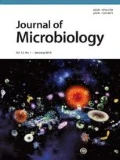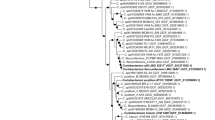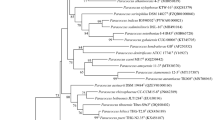Abstract
A Gram-stain-positive, motile, endospore-forming, and strictly aerobic rod-shaped bacterium designated DS80T was isolated from an island soil. The strain DS80T grew at temperatures between 15 and 40°C (optimum = 30°C) and at pH values ranging from 5.0 to 9.0 (optimum = 7.0). The phylogenetic analysis based on the comparisons of the 16S rRNA gene sequences showed that the isolate was affiliated to the genus Paenibacillus and was mostly related to Paenibacillus assamensis GPTSA11T (with the sequence similarity of 96.33%) and Paenibacillus urinalis 5402403T(95.48%). The G+C content of the genomic DNA was 44.0 mol% and the major fatty acids were anteiso-C15:0, iso-C15:0, iso-C16:0, and C16:1 ω11c. Strain DS80T contained MK-7 as the major menaquinone, and phosphatidylglycerol, phosphatidylethanolamine, and diphosphatidylglycerol as the major polar lipids. The peptidoglycan contained a major amount of meso-diaminopimelic acid. The chemotaxonomic profile of strain DS80T was consistent with that of Paenibacillus. However, the phenotypic properties clearly separated the strain from other species of the genus. Accordingly, a new species, Paenibacillus insulae sp. nov., is proposed (type strain =DS80T =JCM 17278T =KCTC 13833T).
Similar content being viewed by others
References
Ash, C., Priest, F.G., and Collins, M.D. 1993. Molecular identification of rRNA group 3 bacilli (Ash, Farrow, Wallbanks and Collins) using a PCR probe test. Proposal for the creation of a new genus Paenibacillus. Antonie van Leeuwenhoek 64, 253–260.
Barrow, G.I. and Feltham, R.K.A. 1993. Cowan and Steel’s Manual for the Identification of Medical Bacteria, 3rded. Cambridge University Press, Cambridge, UK.
Cochrane, S.A. and Vederas, J.C. 2014. Lipopeptides from Bacillus and Paenibacillus spp.: a gold mine of antibiotic candidates. Med. Res. Rev. doi: 10.1002/med.21321.
Collins, M.D. and Jones, D. 1980. Lipids in the classification and identification of coryneform bacteria containing peptidoglycan based on 2,4-diamino butyric acid (DAP). J. Appl. Bacteriol. 48, 459–470.
De Vos, P., Ludwig, W., Schleifer, Kh., and Whitman, W.B. 2009. Family IV. Paenibacillaceae fam. nov. Bergey’s Manual of Systematic Bacteriology, 2nd edn, Vol. 3, p. 269. In De Vos, P., Garrity, G.M., Jones, D., Krieg, N.R., Ludwig, W., Rainey, F., Schleifer, Kh., and Whitman, W.B. (eds.) Springer, New York, USA.
Felsenstein, J. 1981. Evolutionary trees from DNA sequences: a maximum likelihood approach. J. Mol. Evol. 17, 368–376.
Fitch, W.M. 1971. Toward defining the course of evolution: minimum change for a specific tree topology. Syst. Zool. 20, 406–416.
Kim, M., Oh, H.S., Park, S.C., and Chun, J. 2014. Towards a taxonomic coherence between average nucleotide identity and 16S rRNA gene sequence similarity for species demarcation of prokaryotes. Int. J. Syst. Evol. Microbiol. 64, 346–351.
Kates, M. 1986. Techniques of Lipidology, 2nded. Elsevier, Amsterdam, Netherlands.
Lal, S. and Tabacchioni, S. 2009. Ecology and biotechnological potential of Paenibacillus polymyxa: a minireview. Ind. J. Microbiol. 49, 2–10.
Lane, D.J. 1991. 16S/23S rRNA sequencing. pp. 115–175. In Stackebrandt, E. and Goodfellow, M. (eds.), Nucleic Acid Techniques in Bacterial Systematics, Wiley, New York, USA.
Lee, F.L., Kuo, H.P., Tai, C.J., Yokota, A., and Lo, C.C. 2007. Paenibacillus taiwanensis sp. nov., isolated from soil in Taiwan. Int. J. Syst. Evol. Microbiol. 57, 1351–1354.
Marmur, J. and Doty, P. 1962. Determination of the base composition of deoxyribonucleic acid from its thermal denaturation temperature. J. Mol. Biol. 5, 109–118.
Montes, J.M., Mercadé, E., Bozal, N., and Guinea, J. 2004. Paenibacillus antarcticus sp. Nov., a novel psychrotolerant organism from the Antarctic environment. Int. J. Syst. Evol. Microbiol. 54, 1521–1526.
Priest, F.G. 2009. Genus I. Paenibacillus. pp. 269–295. In De Vos, P., Garrity, G.M., Jones, D., Krieg, N.R., Ludwig, W., Rainey, F.A., Schleifer, Kh., and Whitman, W.B. (eds.), Bergey’s Manual of Systematic Bacteriology, 2nded. Springer, New York, USA.
Roux, V., Fenner, L., and Raoult, D. 2008. Paenibacillus provencensis sp. nov., isolated from human cerebrospinal fluid, and Paenibacillus urinalis sp. nov., isolated from human urine. Int. J. Syst. Evol. Microbiol. 58, 682–687.
Saitou, N. and Nei, M. 1987. The neighbor-joining method: a new method for reconstructing phylogenetic trees. Mol. Biol. Evol. 4, 406–425.
Shida, O., Takagi, H., Kadowaki, K., Nakamura, L.K., and Komagata, K. 1997. Transfer of Bacillus alginolyticus, Bacillus chondroitinus, Bacillus curdlanolyticus, Bacillus glucanolyticus, Bacillus kobensis, and Bacillus thiaminolyticus to the genus Paenibacillus and emended description of the genus Paenibacillus. Int. J. Syst. Bacteriol. 47, 289–298.
Stackebrandt, E. and Ebers, J. 2006. Taxonomic parameters revisited: tarnished gold standards. Microbiol. Today 33, 152–155.
Staneck, J.L. and Roberts, G.D. 1974. Simplified approach to identification of aerobic actinomycetes by thin-layer chromatography. J. Appl. Bacteriol. 28, 226–231.
Takeda, M., Suzuki, I., and Koizumi, J. 2005. Paenibacillus hodogayensis sp. Nov., capable of degrading the polysaccharide produced by Sphaerotilus natans. Int. J. Syst. Evol. Microbiol. 55, 737–741.
Tamura, K., Dudley, J., Nei, M., and Kumar, S. 2007. MEGA4: molecular evolutionary genetics analysis (MEGA) software version 4.0. Mol. Biol. Evol. 24, 1596–1599.
Wollum, A.G. 1982. Cultural methods for soil microorganisms, pp. 781–802. In Page, A.L. (eds.), Methods of Soil Analysis, Part 2: Chemical and microbiological properties, 2nd(ed.), American Society of Agronomy, Inc., Soil Science Society of America, Inc., Madison, Wisconsin, USA.
Author information
Authors and Affiliations
Additional information
Supplemental material for this article may be found at http://www.springerlink.com/content/120956.
Electronic supplementary material
Rights and permissions
About this article
Cite this article
Cho, SJ., Cho, SH., Kim, TS. et al. Paenibacillus insulae sp. nov., isolated from soil. J Microbiol. 53, 588–591 (2015). https://doi.org/10.1007/s12275-015-4610-x
Received:
Revised:
Accepted:
Published:
Issue Date:
DOI: https://doi.org/10.1007/s12275-015-4610-x




